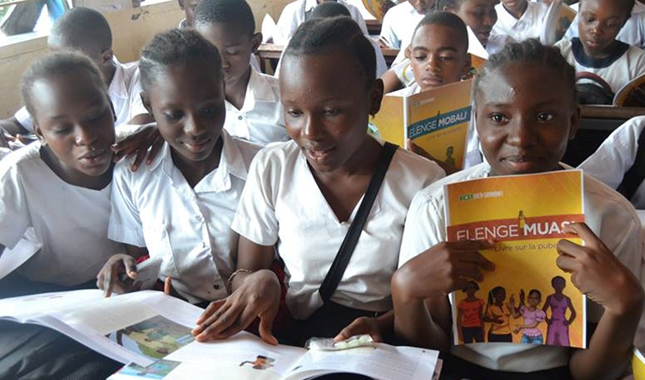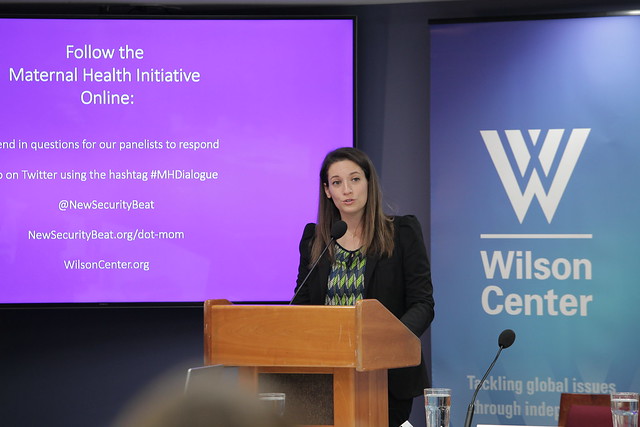-
City Kids: The Sexual, Reproductive, and Maternal Health of Urban Adolescents
December 19, 2017 By Yuval Cohen
“All or most of the children living in these communities are by nature vulnerable,” said Melanie Yahner of Save the Children at a recent Wilson Center event on the sexual, reproductive, and maternal health of urban adolescents. Given that half of the global population living in urban areas today is under the age of 25, addressing the health needs of adolescents living in cities has become critical. “Who is shaping their norms and practices?” said Yahner. “How do we develop and adapt interventions that are meaningful for their needs?”
Reaching Very Young Adolescents
Very young adolescents—those between the ages of 10 and 14—are in the midst of puberty, processing social and gender norms and developing risk-taking behaviors. “Early adolescence is really a critical time to lay the foundation for healthy and fulfilling sexual health lives,” said Yahner, “but this age group tends to be chronically neglected in health policies and programs.”
To fill this gap, Save the Children designed an intervention in the Kinshasa area of the Democratic Republic of Congo, where 13 percent of girls begin childbearing by the age of 19. Save the Children uses an “ecological approach to engage the multiple spheres of influence” that shape norms and practices, said Yahner, including teachers, caregivers, and parents.
Some of the challenges Save the Children faced include overcrowded classrooms, lack of space for after-school activities, and difficulty reaching adolescents who were not enrolled in school. “Girls, in particular, tend to have a lot more restrictions on their movement around the community,” said Yahner, “in part due to safety concerns, and also because they tend to have more responsibilities at home.”
Save the Children also sought to engage the adolescents’ parents, but in the urban areas of DRC, “parents are often busy working multiple jobs,” she said. “It is especially difficult to encourage fathers and other male caregivers to participate in the sessions,” since many of them work outside of Kinshasa or did not live in the same homes as their children.
Proximity to health services was surprisingly sometimes a deterrent: “For adolescents,” said Yahner, “one of the most important factors for seeking health services is being able to do so discreetly without others in the family and the community knowing.”
“We need to challenge ourselves to think holistically about how we define the needs of poor urban adolescents,” said Yahner, “and how we make sure that they have hope for their future.”
Partnering With Young People to Promote Healthy Behaviors
“How might we leverage technology to address teen pregnancy and unemployment among urban girls?” asked Nicole Ippoliti of YLabs, which uses human-centered design to create tailored innovations. “We need to start designing programs with a question rather than a solution,” said Ippoliti.
Working directly with youth in Rwanda, YLabs created Cybergirl, a digital and SMS tool that disseminates health information and promote healthy behaviors. It also includes employment opportunities to incentivize girls and their parents to use the application.
The app provides a “trusted, confidential platform to disseminate accurate information,” said Ippoliti. Using mobile technology to share information can also help young adolescents by reducing their encounters with providers that might be biased against adolescents.
“To design for this generation of young people whose needs are rapidly changing,” said Ippoliti, “we need to work in partnership with them, understand their needs and aspirations, and involve them deeply in the design and implementation of health and development programs.”
Preventing Disrespect and Abuse of Pregnant Adolescents
Adolescent motherhood is a prevalent feature of urban life in many developing countries. In Kenya in 2014, 18 percent of women under 20 years of age had already started childbearing, according to Pooja Sripad from Population Council, and this number has remained steady since 2008.
Young people—particularly poor young people—have less access to information on maternal health and family planning than adults, said Sripad. Young, urban adolescents tend to have less decision-making power, experience more disrespectful care, and have fewer support systems.
“Trust in maternity care really includes trust in providers, in the health facility, [and] in community health workers,” said Sripad—all of which deteriorate after experiencing disrespect from providers.
The Heshima Project, implemented by USAID and Population Council, sought to explore the causes and effects of disrespect and abuse in central and western Kenya. “We learned that about 20 percent of all women in these locations were experiencing some form of disrespect and abuse during their maternity care,” said Sripad. “We also found that age affects the level of disrespectful or respectful care,” and that adolescents often experienced high levels of provider bias.
The Population Council established group-based antenatal care programs in Kenya that sought to create trusted networks for mothers who had experienced this disrespect and abuse. “The group antenatal care model emerged as a particularly important space for young women who were single,” said Sripad.
Meeting the Needs of Urban Adolescents
Urban adolescents have unique health needs that must be addressed appropriately and holistically. To develop interventions that best address these needs, program designers must be conscious of the continuously changing priorities of youth and new ways to reach them. “It’s important to test assumptions,” said Ippoliti, “and be open to failing and pivoting rapidly based on what you learn from your users.”
“It is important that we think about young people’s pathways to care and understand that these are dynamic and changing,” said Sripad, “if we want to make sure that adolescents are using health services to their benefit.”
Sources: Georgetown University Institute for Reproductive Health, Population Council, Y Labs
Photo Credit: Taken by Dr. Pierrot Mbela, Save the Children, Democratic Republic of the Congo and used with permission of Save the Children.
 A Publication of the Stimson Center.
A Publication of the Stimson Center.




